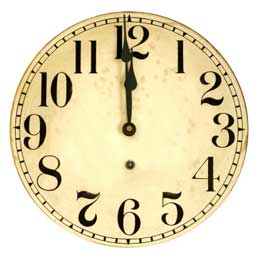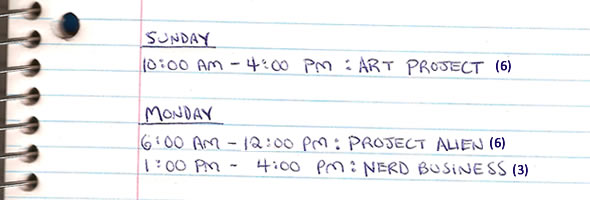The 3, 6, 9 Time Management Strategy
Nikola Tesla said that, "If you only knew the magnificence of the 3, 6 and 9, then you would have a key to the universe."
I am about to share with you a simple time management strategy. One that has had a tremendous impact on my efficiency since the day I first innovated & implemented it. This is not the key to the universe and not every day goes perfect, but more often than not - at the end of every day - you will feel satisfied with the work accomplished. That every client, project, and task is getting just the right amount of time. And be excited to begin the next day.
The strategy achieves its harmony using Tesla's favorite numbers: three, six and nine. Creating ample time for pure, uninterrupted, focused attention (on whatever it is you want to progress). Simplifying the process of scheduling your future (so its easy to plan ahead). And relaxing your brain (to maintain your peak performance).

It's easy to see the significance of Tesla's favorite numbers in the context of time. Look at the face of any clock. Our day is blatantly divided into 3 hour quadrants. Represented by the predominant 3, 6, 9 and 12 ( 1 + 2 = 3).
3 Hours - The Perfect Amount of Time
It only is natural then, to divide your day into 3 hour chunks. I call these chunks 'Focus Blocks'. And you build your day with them.
As the name implies, you use this block of time to focus. Not on a vague list of tasks. Not on several different projects. But rather, on a specific task apart of only a single project.
Anything you focus on for 3 hours per day will eventually get done. Any problem resolved. Any goal achieved. That's a provocative realization! Seems obvious yes, but few of us seem to understand this simple rule. Often we live our lives with a nagging list of 'things', tasks and responsibilities that cause stress. My theory is that this stress is caused not by the fact that 'we have to do it' but rather by our intuitive sense that 'we can do it better'.
To be honest when I first initiated the 3, 6, 9 Time Management Strategy I had, what seemed like, an endless number of projects, tasks, and responsibilities that just never seemed to go away. "I can never get enough done in the day" was my thinking. Because it just seemed like there was too much to do.
This strategy caused a transformation.
It doesn't 'clear the plate' of responsibility, but instead gives you a model for managing time that 'organizes the plate' so you can clearly see everything. And by selectively 'investing' Focus Blocks' into each of these items on the plate - you can eat everything in a civilized manner.
The plate analogy aside, the biggest advantage of the 3, 6, 9 Time Management Strategy is the balance it creates among everything you want to do, everything you should do, and everything you have to do. Ensuring the right amount of time for anything.
The Way You Do It
Throw away the task list and replace it with a new list of just three things. These represent the Focus Blocks of your day. During each block, you'll have 3 hours to focus on just that one thing - whether its a project, a client, or any mundane task.
The Focus Blocks together make up a nine hour day; the perfect work day. More than 8, but less than 12. Here's an example direct from my notebook today.

My first 3 hours of focus for the day are on Nerd Business. Today during this time, I wrote the very article you read now.
Next, after lunch - I have a Focus Block established for my client, Mr. Smith. He and his company recently commissioned me on a project. And I'd like to get it done promptly, so I've actually got this block penciled in almost every day until the project is complete. Finally, in my final three hours of focus - I have "Project Alien" which is a top secret project and that's all I can say about that.
You'll notice in between each Focus Block is an hour long break. This 'buffer zone' is important to help you transition from one Focus Block to the next. Relax, have lunch, play some Tetris - whatever you need to do to get in a comfortable mental state before entering your next Focus Block. The hour long buffer is also helpful because it provides you with flexibility between blocks in case you need another 25 minutes to finish up (ex - today I worked on Mr. Smith's project until 4:32, taking a quick 15 minute powernap and then back in front of the desk for Project Alien by 5:00 PM).
There will always be those days where something comes up, whether its a planned event or the unavoidable occurs - so the advantage of the 3, 6, 9 Time Management Strategy is that you don't always need to stick to a rigid 9 hour day. You can do a 6 hour day, with just two Focus Blocks. Or if you're really pressed for time, your work day can consist of just one 3 hour block. The point is - at the end of the day - you've given yourself at least 3 hours of pure focus on a single area of your life - and that's satisfying.
Your Focus Block Inventory
When you get into this Focus Block stuff you'll begin to invent, think up, and design all sorts of activities you can allocate to Focus Blocks. The thing about a 3 hour block of time - is that you can justify spending 3 hours on just about anything in this world. No matter how minutely important you think it is. Whether your block is reserved for learning a new skill, improving a relationship, or fixing a hole in your wall - after three hours of focus you'll always manifest a measurable improvement.
At first you might be like, okay what the hell am I going to think about for 3 hours while focusing on "Grandma" - but just try it. Let your creativity roam free within the given topic of your Focus Block. I promise your mind will come up with all sorts of interesting ideas and initiatives that will directly improve that area of your life. Things you would have never accomplished had you not sat down to seriously think about it for an extended period of time.
As you come up with these ideas (preferably during times outside of your actual Focus Blocks) list them on a new page labeled 'Focus Block Inventory'. The key is to establish Focus Blocks based on a target area of your life that you want to accomplish forward progress. Here are some examples:
Dream Home: spend 3 hours visualizing, researching & planning your next dream home. Do you want wood counter tops or marble? Hardwood floors or carpet? What color are the walls? It's amazing how so many of us want the perfect home for our family - without ever having dedicated more than a passing thought to the actual process of manifesting that home. To get something you really want in life you have to think about it - and the more time you invest into thinking about a dream the closer to reality that dream will become.
Learn the Piano: anything you seriously want to learn is well deserving of a series of Focus Blocks. If you want to learn a new instrument, the best way to get started is by establishing a 3 hour chunk of time to kickstart the process of educating yourself.
Business Automation: how can you automate things to make your life more efficient? This type of Focus Block is particularly applicable to a business. If you would just spend 3 hours every couple weeks designing wasy & using technology to automate tedious business procedures you could reduce costs, streamline efforts and get paid faster.
And the list can go on and on. The benefit of a focused life is that you no longer have an excuse for procrastinating. Because your mind doesn't have to wander any further than your list of ideas for Focus Blocks. Its comforting knowing that you've got a special time reserved in the future for focusing on a particular idea. And knowing this, you'll become more focused on the task at hand.
Integrating Focus Blocks with a Schedule
With just 3 focus blocks per day and an inventory or 'reservoir' of Focus Blocks to choose from - projecting out to create a weekly schedule becomes simple & fun. As part of this strategy, schedule your days to a maximum of 12 days in advance. Here's a snapshot of my schedule for later this week.

Thursday is my night to cook so I've got a three hour block of time reserved. Which is just enough time to cook something great. Then on Friday, my daily efforts are put into Mr. Smith's project - and then I'm taking the rest of the day off to golf and go out.
It's important you give yourself a day off to break away from the grind every now and then. I like to take at least one of these 'Free Days' about once per week. Whether its Saturday or Tuesday - shouldn't matter. Sometimes the best 'days off' are in the middle of the week when everyone else is working :)
6 and 9 Hour Focus Blocks
While 3 hours is often the perfect amount of time, it can be an advantage to go even longer. Focusing on a single particular area for an extended period of time allows you to 'go deeper'. Breaking through to this deep realm of manifestation is what I believe truly creates spectacular results. And this can certainly be achieved during 6 or 9 hour Focus Blocks.
So as part of the 3, 6, 9 Time Management Strategy, in addition to 3 hour blocks, you can establish 6 and 9 hour Focus Blocks. Instead of a 3 hour chunk, you might have a six hour chunk. The difference in a 6 hour Focus Block would be that your not taking that hour 'buffer zone' after three hours. You take it after the full six hours, only taking short breaks for food & water. Here's 2 days from my next week's schedule with 6 and 9 hour blocks in action.

In this example, on Sunday I have reserved just a single 6 hour Focus Block for an art project. On Monday, I've built a 9 hour work day consisting of a 6 hour block and a 3 hour block. Notice the hour buffer is after the full six hours, and not every 3 hours.
This strategy really works. Since deploying the 3, 6, 9 Time Management Strategy only a month ago, I have already earned more revenue for my companies than in all of the three previous months combined. I feel this is directly attributed to a balanced schedule of focused time blocks. Every client, project, and task is getting just the right amount of time. And I'm excited to begin the next day.


